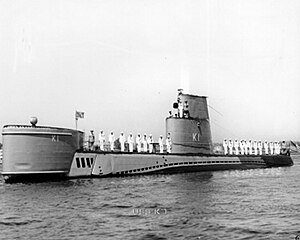| USS Barracuda (SSK-1) | |
|---|---|
 | |
| Career (United States of America) | |
| Name: | USS Barracuda |
| Builder: | Electric Boat Company, Groton, Connecticut [1] |
| Laid down: | 1 July 1949 [1] |
| Launched: | 2 March 1951 [1] |
| Commissioned: | 10 November 1951 [1] |
| Decommissioned: | 15 August 1959 |
| Struck: | 1 October 1973 [1] |
| Fate: | Sold for scrap, 21 March 1974 [1] |
| Status: | Scrapped |
| General characteristics | |
| Class & type: | Barracuda-class diesel-electric hunter-killer submarine |
| Displacement: |
765 long ton (777 tonne) surfaced 1,160 tons (1179 t) submerged |
| Length: | 196 ft 1 in (59.77 m) overall [1] |
| Beam: | 24 ft 7 in (7.49 m) [1] |
| Draft: | 14 ft 5 in (4.39 m) mean[1] |
| Propulsion: |
3 × General Motors diesel engines, total 1050 bhp (0.8 MW) 2 × General Electric electric motors two screws [1] |
| Speed: |
13 knots (24 km/h) surfaced 8.5 knots (16 km/h) submerged [1] |
| Test depth: | 400 ft (120 m) [1] |
| Complement: | 37 officers and men [1] |
| Armament: | 4 × 21 in (533 mm) torpedo tubes |
USS Barracuda (SSK-1/SST-3/SS-550), the lead ship of her class, was the second ship of the United States Navy to be named for the barracuda, a voracious, pike-like fish. Her keel was laid down on 1 July 1949 by the Electric Boat Division of General Dynamics Corporation in Groton, Connecticut. She was launched on 2 March 1951 as K-1 sponsored by Mrs. Willis Manning Thomas, and commissioned on 10 November 1951 with Lieutenant Commander F. A. Andrews in command. Notably, United States President Jimmy Carter served as an officer on the SSK-1 during its first year of active duty.[2]
The three SSK boats, Barracuda (SSK-1), Bass (SSK-2), and Bonita (SSK-3), were equipped with the large BQR-4 bow-mounted sonar array as part of Project Kayo, which experimented the use of passive acoustics with low-frequency, bow sonar arrays. When the boat was rigged for silent running, these arrays gave greatly improved convergence zone detection ranges against snorkeling submarines. The SSKs themselves were limited in their anti-submarine warfare abilities by their low speed and their need to snorkel periodically, but the advances in sonar technology they pioneered were invaluable to later nuclear-powered submarines.
Barracuda joined Submarine Development Group 2, which was stationed at her home port at New London, Connecticut. She cruised along the Atlantic coast of the United States and Canada, in the Caribbean Sea, and made a voyage to Greenock and Rothesay, Scotland, in June 1955. On 16 December 1956 her name was changed from K-1 to Barracuda (SSK-1). During intervals between and after these cruises, Barracuda operated along the eastern seaboard carrying out training and experimental exercises.
Redesignation and Decommissioning[]
Barracuda was redesignated SST-3 on 3 July 1959. On 15 August 1959 she was re-redesignated SS-550, the same day she was decommissioned. She was scrapped between 8 April and 8 July 1974 near Charleston, South Carolina, possibly at the Braswell Shipyards.
References[]
- ↑ 1.00 1.01 1.02 1.03 1.04 1.05 1.06 1.07 1.08 1.09 1.10 1.11 1.12 Bauer, K. Jack; Roberts, Stephen S. (1991). "Register of Ships of the U.S. Navy, 1775-1990: Major Combatants". Greenwood Press. ISBN 0-313-26202-0.
- ↑ Jimmy Carter Library and Museum, Jimmy Carter's Naval Service. Retrieved 5 February 2008
- This article incorporates text from the public domain Dictionary of American Naval Fighting Ships. The entry can be found here.
The original article can be found at USS Barracuda (SSK-1) and the edit history here.